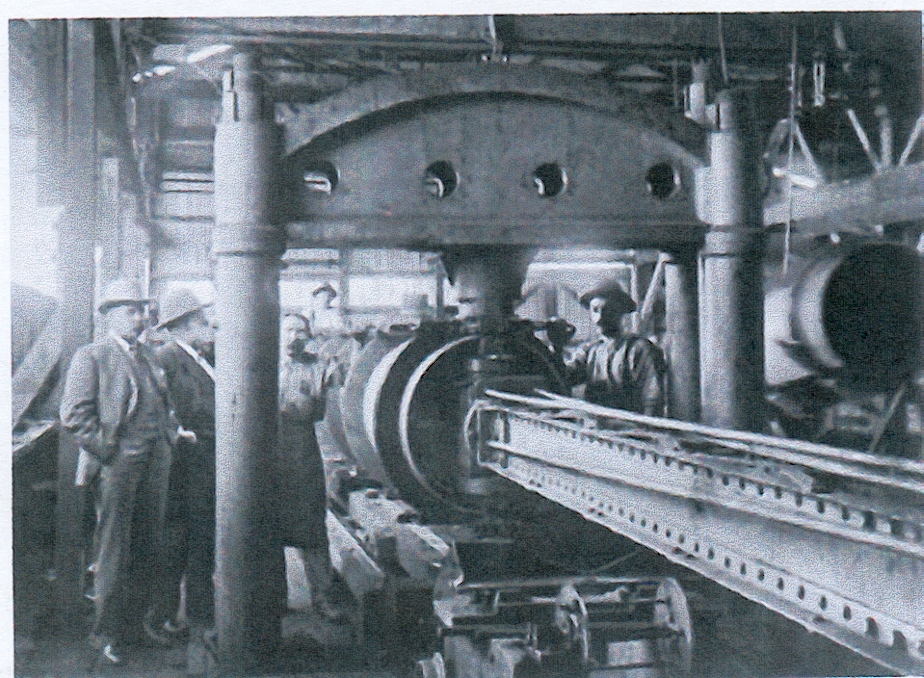The cover had the orange printed 2d stamp of Victoria which was cancelled with the duplex MELBOURNE/ 10A/ AP 1/ 91 with the VICTORIA obliterator over the stamp. It was addressed to Messrs. W.H. Smith & Sons Ld, Market St., City (Figure 1).
The reverse had a large cylinder of a pipe with the name ‘MEPHAN FERGUSON’ on it. The flap had CARLTON FOUNDRY/ Engineer, &c./ Melbourne printed in black (Figure 2).
Mephan Ferguson, manufacturer, was born on 25 July 1843 at Falkirk, Scotland, son of John Ferguson, contractor, and his wife, née Boyd. He arrived in Melbourne with his parents in 1854 on the Admiral Boxer and after three years at Emerald Hill he moved to Ballarat, where he was indentured to John Price, a prosperous blacksmith. Seventeen years later he returned to Melbourne to establish himself as an ironfounder and railway contractor. The successful completion of one of his first large contracts, a bridge over the Yarra, enabled him to obtain much government work. He built twenty bridges on the north-eastern railway and eight on the Clifton Hill line; he manufactured and erected many footbridges, engine traverses and station verandahs, and he also fabricated the wrought-iron and cast-iron work, some 1300 tons in weight, for the Newport railway workshops. The cast-iron and wrought-iron work for the Maryborough and Seymour engine sheds came from his establishment, and he built up a large trade in bolts, nuts and buffers for the Victorian and other colonial railways.
Ferguson owed his early success to his entrepreneurial and technical skills and to the government’s protectionist policy of awarding contracts to colonial firms. By 1885 he was well established. In that year, when Alfred Deakin returned from California and decided that wrought-iron pipes should replace cast-iron in the Melbourne water supply, Ferguson acted promptly. He won government contracts for the supply of wrought-iron piping, and bought the Glasgow Iron Works in West Melbourne where he established a new factory and testing works. He also imported the latest hydraulic machinery and designed a plant said to match any in the world. Ferguson had earlier bought the Carlton foundry, and now employed 300 hands. His outlay was more than covered by an output of £150,000 a year, and he soon had to establish new buildings on a ten-acre (4 ha) site at Footscray. A picture of his pipe-making foundry is seen in Figure 3.

Ferguson continued his experiments with wrought-iron pipes, and perfected straight-riveted, longitudinal and transverse seams and, more important, pipes with spiral seams. 113 km of this lighter piping was used in the Melbourne water supply by 1909, while Ferguson also supplied the pipes for many of the Victorian Water Trusts. He patented a locking bar or rivetless pipe which was first used by the South Australian government. He achieved world-wide attention by defeating overseas competitors for the contract to supply 530 km of 76 cm steel main for the Kalgoorlie pipeline in Western Australia. A picture of Ferguson (third from left) and his lieutenants watching the loading of his pipes on a train is seen in Figure 4.
Soon afterwards he won a large contract for the Mona Gas Co. at Tipton, South Staffordshire, despite heavy competition. He designed and manufactured his own plant at Footscray, and shipped it to England where his work was highly praised. Ferguson continued to expand his bridge and railway work, despite the depression in the 1890s, and held many contracts for wrought-iron piping in the Australian colonies. The firm also developed a large general engineering trade, including marine boilers, and won contracts for various sewerage schemes. His continued emphasis on innovation and research, and his policy of reinvesting profits in the firm accounted for much of its success.
Ferguson first married, Agnes Shand, by whom he had five sons and two daughters, and second, Maggie Kennedy, by whom he had one daughter. He died at Falkirk, Royal Parade, Parkville, on 2 November 1919, leaving an estate worth £14,000. He was survived by three sons and three daughters. The vast industry Ferguson built declined after his death but he had shown what enterprise and research could achieve. A picture of Mephan Ferguson is seen in Figure 5.
This paper is extracted from the Australian Dictionary of Biography.